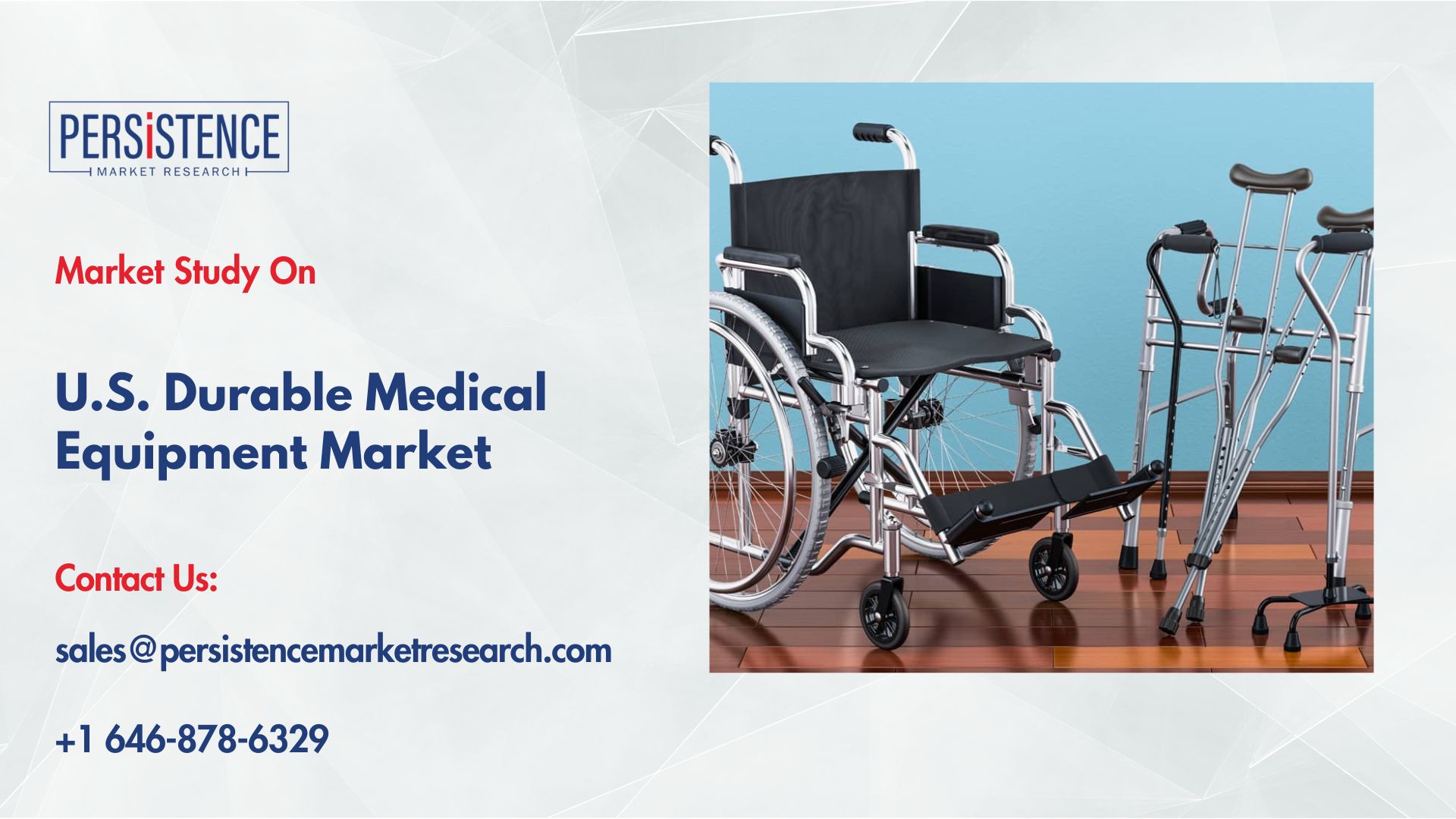U.S. Durable Medical Equipment Market Supply Chain Dynamics and Strategies

Strong 8k brings an ultra-HD IPTV experience to your living room and your pocket.
Introduction
The U.S. Durable Medical Equipment (DME) market has seen steady growth in recent years, fueled by an aging population, increased healthcare expenditures, and technological advancements in medical devices. The sector encompasses a wide range of medical devices, including wheelchairs, oxygen equipment, blood glucose monitors, and hospital beds, among others. However, with this growth comes the challenge of managing an increasingly complex supply chain.
The U.S. durable medical equipment market size is projected to rise from US$ 70.5 Bn in 2025 to US$ 103.3 Bn by 2032. It is anticipated to witness a CAGR of 5.6% during the forecast period from 2025 to 2032. Increasing prevalence of chronic diseases in the U.S. is estimated to open the door to new opportunities. America’s Health Rankings 2023 annual report, for example, stated that in 2022 alone, around 133 Mn individuals, i.e., nearly 43% of the population in the U.S., was living with one or more chronic diseases.
In this article, we will examine the key supply chain dynamics in the U.S. durable medical equipment market and explore the strategies companies are employing to overcome challenges, optimize operations, and maintain efficiency in a rapidly evolving healthcare environment.
Understanding the Durable Medical Equipment Supply Chain
The supply chain for durable medical equipment is multi-faceted and involves several stages, from raw materials sourcing to product delivery to end-users, which can include hospitals, clinics, long-term care facilities, and home healthcare providers. The DME supply chain typically follows the flow outlined below:
1. Manufacturers and Suppliers: The first stage involves the design, manufacturing, and sourcing of raw materials for medical devices. Manufacturers focus on producing high-quality and compliant equipment while ensuring they meet healthcare regulations and certifications.
2. Distributors and Wholesalers: Once the products are manufactured, they are distributed through wholesalers and distributors. These intermediaries play a crucial role in inventory management, logistics, and product availability to healthcare facilities and home healthcare providers.
3. Healthcare Providers and Retailers: Durable medical equipment is sold or leased to healthcare providers, including hospitals, rehabilitation centers, and nursing homes. It is also available through retailers, such as pharmacies, online stores, and medical supply companies that sell directly to consumers.
4. End-Users: The final stage involves the end-users of the equipment, typically patients, caregivers, or medical staff, who use the devices to aid in diagnosis, treatment, or recovery.
Key Supply Chain Dynamics in the DME Market
1. Regulatory Compliance
The U.S. healthcare sector, particularly the DME market, is highly regulated. The Food and Drug Administration (FDA) imposes strict standards on the production and distribution of medical devices. Compliance with these regulations is essential at every stage of the supply chain. Manufacturers and suppliers must adhere to the FDA's guidelines for device safety, effectiveness, and quality control.
In addition to FDA regulations, companies must also comply with Medicare and Medicaid reimbursement policies, which impact pricing and sales of DME. Healthcare providers and suppliers are tasked with ensuring that all devices are eligible for reimbursement under these programs, which are essential to the financial viability of the DME market.
2. Supply Chain Transparency and Traceability
The push for increased transparency in the supply chain has gained significant momentum. Stakeholders in the U.S. DME market, especially healthcare providers and patients, are demanding more visibility into where products come from, how they are made, and whether they meet necessary safety standards. This transparency is crucial for building trust and ensuring that products are safe and effective.
Supply chain traceability is increasingly important in managing product recalls, which can have significant health and safety implications. Companies must implement robust tracking systems to trace the origin and history of their medical equipment, ensuring quick action can be taken in the event of a recall or safety concern.
3. Logistics and Inventory Management
Effective logistics and inventory management are key to maintaining a smooth DME supply chain. Timely delivery of equipment is critical, especially for patients who require specialized devices for chronic conditions, mobility, or home care.
Just-in-time (JIT) inventory strategies are commonly employed to minimize inventory costs and ensure that equipment is available when needed. However, the unpredictability of demand, fluctuations in healthcare needs, and potential disruptions in global supply chains (such as those caused by the COVID-19 pandemic) have challenged traditional JIT approaches.
As a result, many companies are adopting more flexible inventory strategies, including safety stock and dynamic inventory models, to cope with supply chain volatility and ensure product availability.
4. Global Sourcing and Supply Chain Disruptions
Many durable medical equipment manufacturers rely on global sourcing for raw materials and components. For instance, parts for medical imaging devices or oxygen concentrators may be sourced from countries like China, India, or Germany. The global nature of the supply chain increases the risk of disruptions, whether due to geopolitical issues, trade tariffs, natural disasters, or global pandemics.
In recent years, the DME sector has been significantly impacted by supply chain disruptions. The COVID-19 pandemic, for example, led to shortages of key components such as ventilators and personal protective equipment (PPE), forcing companies to rethink their sourcing strategies and diversify suppliers to reduce dependency on specific regions.
5. Technology Integration
Technology has become an essential tool in optimizing the DME supply chain. Companies are increasingly turning to Enterprise Resource Planning (ERP) systems to streamline their operations, from inventory management to order fulfillment. These systems enable companies to manage large amounts of data, improve communication across the supply chain, and reduce operational inefficiencies.
Blockchain technology is also being explored for improving transparency, ensuring secure transactions, and enhancing traceability. By creating an immutable ledger of transactions, blockchain can help medical equipment manufacturers and distributors track products in real-time, ensuring compliance with safety regulations and improving the overall reliability of the supply chain.
6. Rising Demand for Home Healthcare Solutions
The shift toward home healthcare has been a significant driver in the growth of the DME market, especially with the increasing aging population and the desire to provide healthcare services in the home setting. This trend has led to increased demand for products such as home oxygen therapy devices, mobility aids, and diagnostic equipment.
Supply chains must be adapted to meet the specific needs of home healthcare providers, including faster delivery times, easier product setup and use, and specialized customer support services. Healthcare providers, in turn, require a more direct relationship with suppliers to ensure their patients have access to the right devices in a timely manner.
Strategies to Optimize the DME Supply Chain
1. Strategic Partnerships and Collaborations
To enhance efficiency and reduce costs, many durable medical equipment manufacturers are forming strategic partnerships with logistics providers and third-party distributors. These collaborations help streamline supply chain processes, reduce lead times, and improve product availability across the U.S.
Strategic collaborations with technology companies are also gaining traction. For instance, manufacturers are leveraging advanced analytics and AI to forecast demand more accurately, optimize supply chain processes, and reduce costs associated with overstocking or stockouts.
2. Local Sourcing and Manufacturing
In response to global supply chain disruptions, many companies are looking to source more materials locally or near-shore production facilities. By reducing dependency on international suppliers, DME companies can mitigate the risks associated with long lead times and geopolitical instability. Additionally, local sourcing can reduce carbon footprints, supporting sustainability initiatives within the healthcare industry.
3. Enhanced Supply Chain Visibility
As the demand for greater transparency grows, supply chain visibility tools have become increasingly important. Manufacturers and distributors are implementing real-time tracking systems that allow stakeholders to monitor the status of shipments, inventory levels, and order fulfillment in real-time.
These tools can help identify bottlenecks, anticipate demand fluctuations, and ensure the timely delivery of products. This enhanced visibility is critical for maintaining strong relationships with healthcare providers, especially as they are under pressure to meet patient care demands.
4. Data-Driven Decision Making
The use of big data and analytics has become a cornerstone of modern supply chain management in the DME sector. By analyzing patient data, market trends, and historical sales data, companies can forecast demand more accurately and plan their production and distribution strategies accordingly.
Data-driven decision-making allows businesses to be more agile and respond quickly to changes in the market, such as shifts in demand for specific medical devices or disruptions in supply chain operations.
Conclusion
The U.S. durable medical equipment market faces numerous supply chain challenges, but the sector's adaptability and innovation continue to drive success. By leveraging technological advancements, fostering strategic partnerships, and adopting more flexible supply chain strategies, companies are overcoming obstacles and meeting the growing demand for high-quality medical devices.
As the healthcare landscape evolves, especially with the rise of home healthcare and the ongoing need for cost-effective solutions, durable medical equipment companies will need to continuously refine their supply chain strategies. By focusing on efficiency, transparency, and collaboration, they can continue to meet the needs of healthcare providers and improve patient outcomes.
Note: IndiBlogHub features both user-submitted and editorial content. We do not verify third-party contributions. Read our Disclaimer and Privacy Policyfor details.







